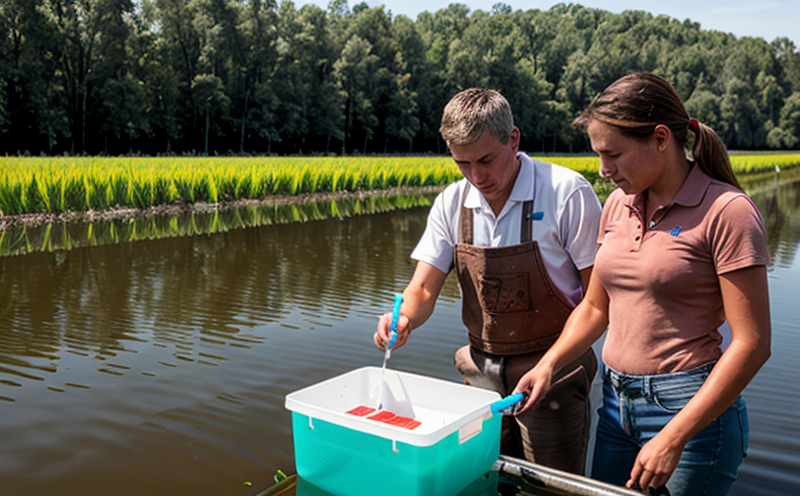Iron Content Testing in Agricultural Water
The testing of iron content in agricultural water is critical for ensuring both crop health and food safety. Iron is an essential micronutrient that plants need for photosynthesis, chlorophyll production, and overall growth. However, excessive levels of iron can be detrimental to plant life by causing toxicity or interfering with other nutrient absorption processes.
In the context of agriculture, water quality directly impacts crop yield, soil health, and ultimately, food safety. Iron content in agricultural irrigation water is typically measured in parts per million (ppm). The acceptable range for iron levels varies depending on the specific crops being cultivated and local environmental conditions. For instance, for most row crops like wheat or corn, an optimal concentration of iron should be between 0.1 ppm to 2 ppm.
The importance of accurate iron content testing cannot be overstated. It helps in optimizing irrigation practices, reducing unnecessary chemical applications, and preventing potential soil contamination issues. Water with excessive iron can lead to the formation of insoluble compounds that may settle in the soil, affecting root growth and nutrient availability over time.
Our laboratory utilizes advanced analytical techniques such as Atomic Absorption Spectroscopy (AAS) for precise determination of iron content. This method provides high sensitivity and selectivity, ensuring accurate measurement even at trace levels. Additionally, we employ validated methods compliant with international standards like ISO 6245:1997, which are specifically designed to measure dissolved iron in water samples.
Proper sample preparation is crucial for reliable results. Samples are filtered through a 0.45 micrometer filter before analysis to remove any particulate matter that could interfere with the measurement process. After filtration, the solution is diluted if necessary to fit within the linear range of the analytical instrument used.
The testing procedure involves several steps: collection and preservation of water samples, filtration, dilution (if required), and finally, the actual analysis using AAS. The results are reported in ppm with a precision that meets industry standards. This information is invaluable for farmers and agricultural professionals looking to make informed decisions about their irrigation practices.
Our team of experts can provide comprehensive advice on how best to use these test results to improve crop performance, optimize water usage, and maintain soil health. By understanding the iron content in your agricultural water, you can tailor your farming strategies to enhance productivity while minimizing environmental impact.
Scope and Methodology
The scope of our iron content testing services includes a comprehensive examination of the iron concentration in various types of agricultural water, such as surface water, groundwater, and reclaimed water used for irrigation. Our methodology adheres strictly to ISO 6245:1997 guidelines ensuring consistency and reliability across all tests.
- Sample Collection: We recommend collecting water samples from representative locations within the field or irrigation system.
- Preservation: Samples are preserved using appropriate chemicals to prevent degradation before analysis.
- Filtration: All samples undergo filtration through a 0.45 micrometer filter to ensure only dissolved iron is measured.
- Dilution (if necessary): Solutions are diluted to fit within the linear range of the AAS instrument.
- Analysis: Using Atomic Absorption Spectroscopy, we measure the concentration of iron in ppm.
The results from this analysis provide a clear picture of the iron content in your agricultural water. These data points can then be used to adjust irrigation practices or recommend corrective measures if necessary.
Quality and Reliability Assurance
To ensure the highest level of accuracy and reliability in our iron content testing services, we implement stringent quality control protocols. These include regular calibration checks of our instruments against known standards, participation in proficiency testing programs organized by recognized bodies such as the National Institute of Standards and Technology (NIST), and internal audits conducted periodically.
- Calibration: All equipment is regularly calibrated to ensure accuracy within ±2% of the expected value.
- Proficiency Testing: We participate annually in external proficiency testing schemes which further validate our analytical capabilities.
- Audits: Internal audits are carried out quarterly to monitor compliance with international standards and internal procedures.
We also maintain robust documentation practices, ensuring all test results are accurately recorded and traceable back to the original sample collection. This comprehensive approach guarantees that every test result you receive is reliable and can be trusted for decision-making purposes.
Use Cases and Application Examples
| Use Case | Description |
|---|---|
| Irrigation Water Management | Determining iron content helps in optimizing irrigation practices, ensuring crops receive the right amount of nutrients without being exposed to harmful levels. |
| Soil Health Improvement | Evaluating water quality can guide interventions aimed at improving soil health and preventing potential contamination issues. |
| Farm Compliance Monitoring | Ensuring compliance with local regulations regarding agricultural water quality is crucial for maintaining good standing in the community. |
| Crop Yield Enhancement | By understanding iron content, farmers can adjust their farming practices to enhance crop yields and overall productivity. |
- Precision Agriculture: Iron data helps in precision agriculture by providing insights into soil nutrient dynamics.
- Farm Management: Monitoring iron levels supports effective farm management strategies aimed at sustainability and efficiency.
These examples illustrate the broad applicability of our testing services across different aspects of agricultural operations. Whether you are a large-scale farmer or an R&D engineer, our expertise can significantly contribute to your success in managing water resources effectively.





